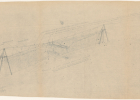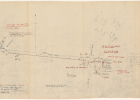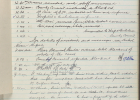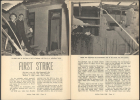Japanese submarines attack
It was submarines, rather than aircraft carriers, that would arrive in NSW. Between 16 May and 27 July 1942 Japanese I-Class submarines attacked fourteen merchant ships and a fishing trawler off south east Australia (from Port Macquarie NSW to Mallacoota Victoria). Seven ships were sunk and 62 seamen killed. Reconnaissance float planes carried by the submarines flew over Melbourne (26 February), Hobart (1 March) and Sydney (17 February, 23 May and 30 May).
Midget submarines, carried by three of the I-class submarines, entered Sydney Harbour on 31 May-1 June and attacked warships and torpedoed the Kuttabul, killing 19 Australian and 2 British naval personnel.
In the early hours of 8 June, submarine I-24 fired ten high explosive shells into Sydney’s eastern suburbs for 10 minutes. The exact number of shells fired by submarine I-21 during its same day 16 minute bombardment of Newcastle is not known. However using both official sources and eyewitness accounts, Jones and Carruthers estimate a total of 21 shells, most like 15 high explosive shells and 6 star shells. Many of the shells that fell on Sydney and Newcastle failed to explode.
List of images used in this Gallery
1. Proposed Sydney Harbour protection net – NRS 20011 [18/1716.2]
2. Plan of Sydney Harbour protection net – NRS 20011 [18/1716.2]
3. Shelling of Sydney, 8 June 1942 – NRS 20003 [16/16016 p.33]
4. NES report of shelling of Sydney – NRS 20003 [16/16016 p.33]
5. Eastern Suburbs shelling damage – NRS 19987 [6/16010.4 Vol.1 No. 4, pp.10-14]
Further reading
- NAA: Fact Sheet 192 – Japanese midget submarine attacks on Sydney, 1942
- AWM – G. Hermon Gill, Australia in the War of 1939-45, Series 2, Vol II – Royal Australian Navy, 1942-45 (in particular see Chapter 3, pp 58-99)
- David Jenkins, Battle Surface! Japan’s Submarine War against Australia 1942-44, Sydney, Random House, 1992
- Terry Jones and Steven Carruthers. A Parting Shot: Shelling of Australia by Japanese Submarines 1942, Narrabeen, Casper Publications, 2013
Research by
Research for the World War II:1942 Gallery was completed by Jennifer Sloggett of State Records NSW.







